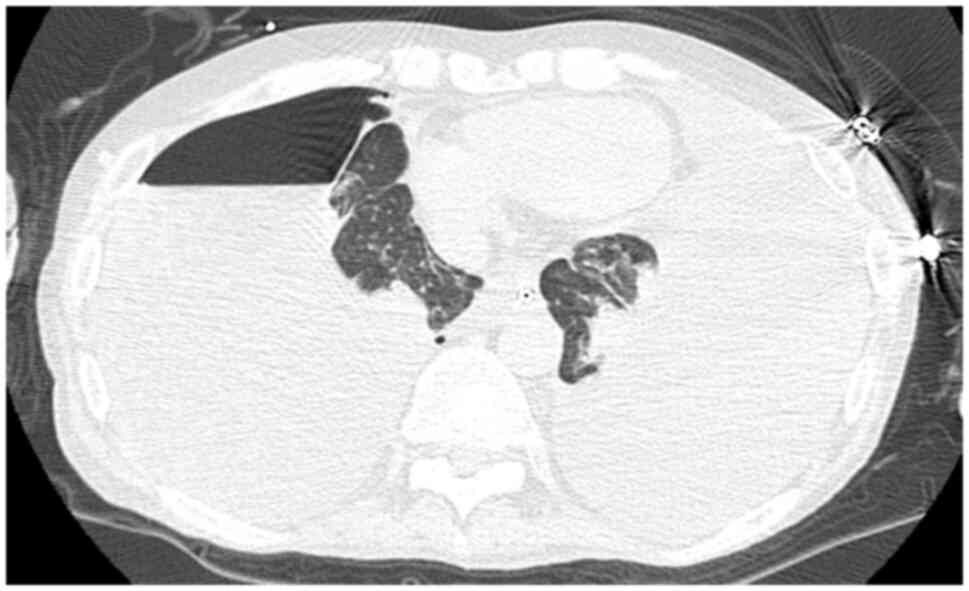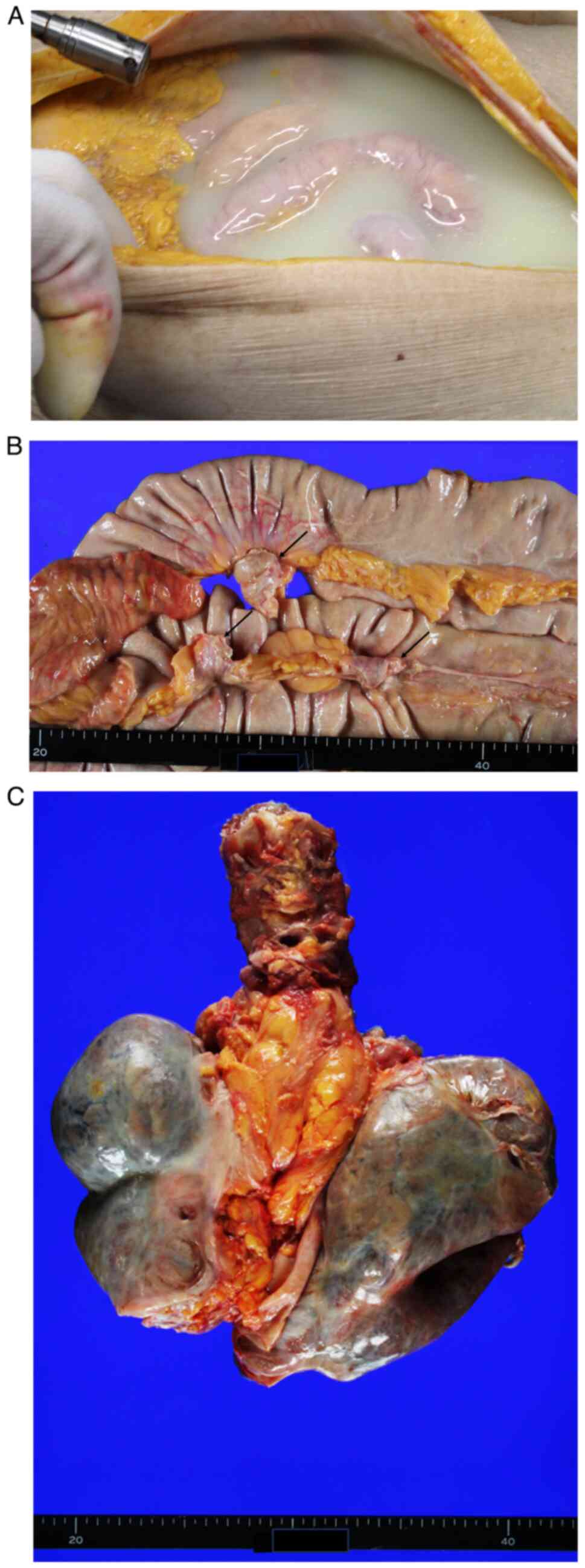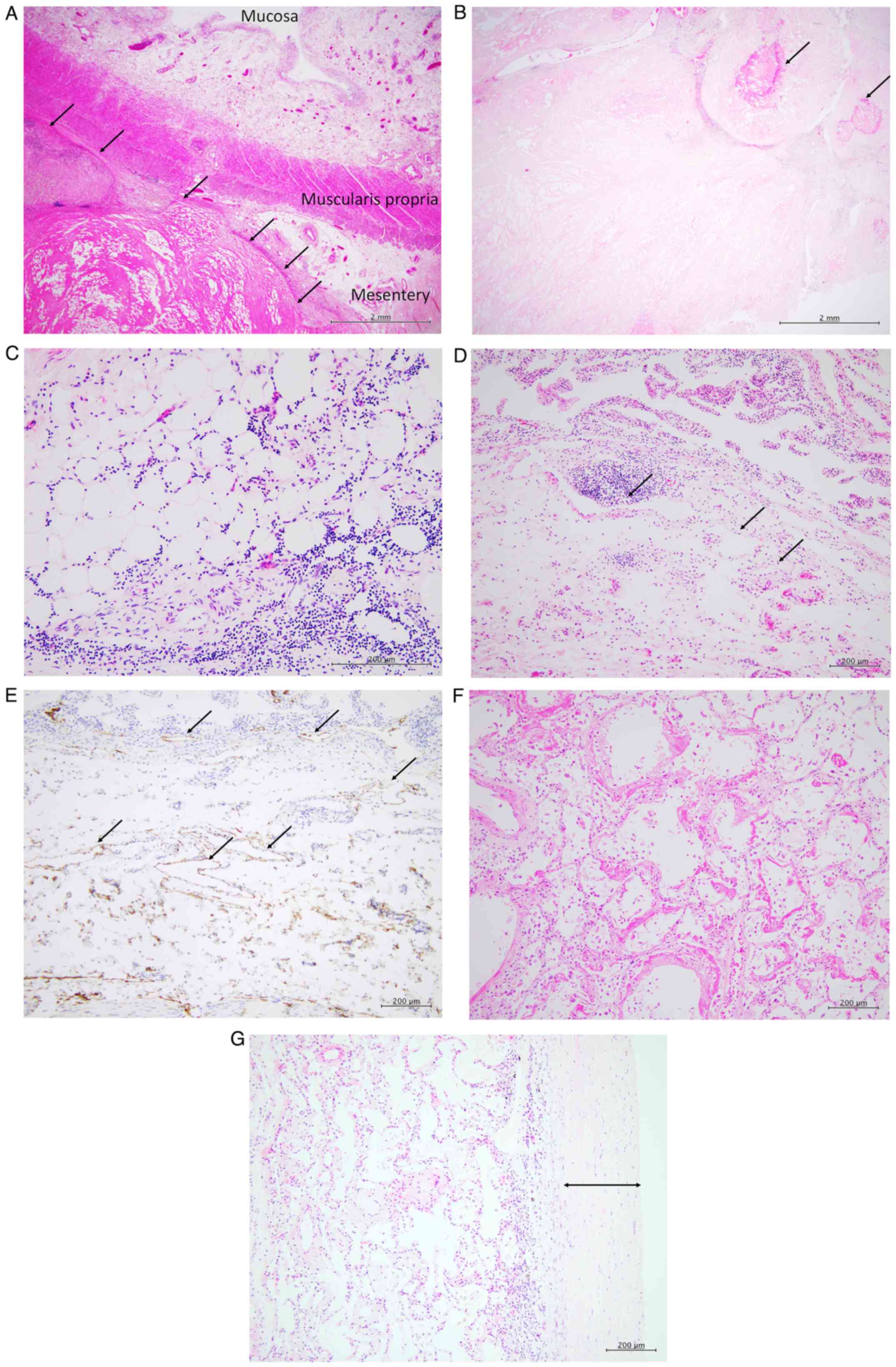|
1
|
Sharma P, Yadav S, Needham CM and
Feuerstadt P: Sclerosing mesenteritis: A systematic review of 192
cases. Clin J Gastroenterol. 10:103–111. 2017.PubMed/NCBI View Article : Google Scholar
|
|
2
|
Emory TS, Monihan JM, Carr NJ and Sobin
LH: Sclerosing mesenteritis, mesenteric panniculitis and mesenteric
lipodystrophy: A single entity? Am J Surg Pathol. 21:392–398.
1997.PubMed/NCBI View Article : Google Scholar
|
|
3
|
Ogden WW II, Bradburn DM and Rives JD:
Mesenteric panniculitis: Review of 27 cases. Ann Surg. 161:864–875.
1965.PubMed/NCBI View Article : Google Scholar
|
|
4
|
Akram S, Pardi DS, Schaffner JA and Smyrk
TC: Sclerosing mesenteritis: Clinical features, treatment, and
outcome in ninety-two patients. Clin Gastroenterol Hepatol.
5:589–596. 2007.PubMed/NCBI View Article : Google Scholar
|
|
5
|
Arora M and Dubin E: A clinical case
study: Sclerosing mesenteritis presenting as chylous ascites.
Medscape J Med. 10(30)2008.PubMed/NCBI
|
|
6
|
Ehrenpreis ED, Boiskin I and Schaefer K:
Chylous ascites in a patient with mesenteric panniculits. J Clin
Gastroenterol. 42:327–328. 2008.PubMed/NCBI View Article : Google Scholar
|
|
7
|
Lim HW and Sultan KS: Sclerosing
mesenteritis causing chylous ascites and small bowel perforation.
Am J Case Rep. 18:696–699. 2017.PubMed/NCBI View Article : Google Scholar
|
|
8
|
Rice BL, Stoller JK and Heresi GA:
Transudative chylothorax associated with sclerosing mesenteritis.
Respir Care. 55:475–477. 2010.PubMed/NCBI
|
|
9
|
Kobayashi H, Notohara K, Otsuka T,
Kobayashi Y, Ujita M, Yoshioka Y, Suzuki N, Aoyagi R, Ohashi R and
Suzuki T: An autopsy case of mesenteric panniculitis with massive
pleural effusions. Am J Case Rep. 19:13–20. 2018.PubMed/NCBI View Article : Google Scholar
|
|
10
|
Ozen A and Lenardo MJ: Protein-losing
enteropathy. N Engl J Med. 389:733–748. 2023.PubMed/NCBI View Article : Google Scholar
|
|
11
|
Strober and Fuss IJ: Protein-losing
enteropathies. In: Mestecky J, Strober W, Russell MW, eds. Mucosal
Immunology. 4th ed. Academic Press, Boston, 1667-1694, 2015.
|
|
12
|
Höring E, Hingerl T, Hens K, von Gaisberg
U and Kieninger G: Protein-losing enteropathy: First manifestation
of sclerosing mesenteritis. Eur J Gastroenterol Hepatol. 7:481–483.
1995.PubMed/NCBI
|
|
13
|
Rajendran B and Duerksen DR: Retractile
mesenteritis presenting as protein-losing gastroenteropathy. Can J
Gastroenterol. 20:787–789. 2006.PubMed/NCBI View Article : Google Scholar
|
|
14
|
Kida T, Suzuki K, Matsuyama T, Okita M,
Isozaki Y, Matsumoto N, Miki S, Nagao Y, Kawabata K, Kohno M and
Oyamada H: Sclerosing mesenteritis presenting as protein-losing
enteropathy: A fatal case. Intern Med. 50:2845–2849.
2011.PubMed/NCBI View Article : Google Scholar
|
|
15
|
Endo K, Moroi R, Sugimura M, Fujishima F,
Naitoh T, Tanaka N, Shiga H, Kakuta Y, Takahashi S, Kinouchi Y and
Shimosegawa T: Refractory sclerosing mesenteritis involving the
small intestinal mesentery: A case report and literature review.
Intern Med. 53:1419–1427. 2014.PubMed/NCBI View Article : Google Scholar
|
|
16
|
Rispo A, Sica M, Bucci L, Musto D, Camera
L, Ciancia G, Luglio G and Caporaso N: Protein-losing enteropathy
in sclerosing mesenteritis. Eur Rev Med Pharmacol Sci. 19:477–480.
2015.PubMed/NCBI
|
|
17
|
Saito Y, Hiramatsu K, Nosaka T, Ozaki Y,
Takahashi K, Naito T, Ofuji K, Matsuda H, Ohtani M, Nemoto T, et
al: A case of protein-losing enteropathy caused by sclerosing
mesenteritis diagnosed with capsule endoscopy and double-balloon
endoscopy. Clin J Gastroenterol. 10:351–356. 2017.PubMed/NCBI View Article : Google Scholar
|
|
18
|
Ordóñez NG: Podoplanin: A novel diagnostic
immunohistochemical marker. Adv Anat Pathol. 13:83–88.
2006.PubMed/NCBI View Article : Google Scholar
|
|
19
|
Liu Z, Jiao Y, He L, Wang H and Wang D: A
rare case report of immunoglobulin G4-related sclerosing
mesenteritis and review of the literature. Medicine (Baltimore).
99(e22579)2020.PubMed/NCBI View Article : Google Scholar
|
|
20
|
Avincsal MO, Otani K, Kanzawa M, Fujikura
K, Jimbo N, Morinaga Y, Hirose T, Itoh T and Zen Y: Sclerosing
mesenteritis: A real manifestation or histological mimic of
IgG4-related disease? Pathol Int. 66:158–163. 2016.PubMed/NCBI View Article : Google Scholar
|
|
21
|
Wang H, Zhao Z, Cao Q and Ning J: A review
of 17 cases of mesenteric panniculitis in Zhengzhou ninth people's
hospital in China. BMC Gastroenterol. 24(48)2024.PubMed/NCBI View Article : Google Scholar
|
|
22
|
Cardenas A, Kelleher T and Chopra S:
Review article: Hepatic hydrothorax. Aliment Pharmacol Ther.
20:271–279. 2004.PubMed/NCBI View Article : Google Scholar
|
|
23
|
Roussos A, Philippou N, Mantzaris GJ and
Gourgouliannis KI: Hepatic hydrothorax: Pathophysiology diagnosis
and management. J Gastroenterol Hepatol. 22:1388–1393.
2007.PubMed/NCBI View Article : Google Scholar
|
|
24
|
Huggins JT, Sahn SA, Heidecker J, Ravenel
JG and Doelken P: Characteristics of trapped lung: Pleural fluid
analysis, manometry, and air-contrast chest CT. Chest. 131:206–213.
2007.PubMed/NCBI View Article : Google Scholar
|
|
25
|
Owen SC, Bersabe DR, Skabelund AJ, McCann
ET and Morris MJ: Transudative chylothorax from cirrhosis
complicated by lung entrapment. Respir Med Case Rep.
28(100243)2016.PubMed/NCBI View Article : Google Scholar
|













